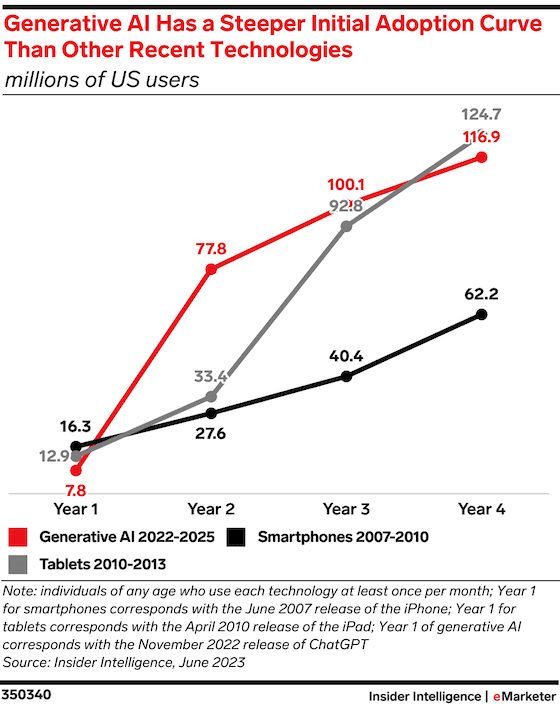TL;DR:
- Generative AI, exemplified by ChatGPT, is outpacing the adoption rates of smartphones and tablets.
- Accessibility due to no new hardware requirements drives rapid uptake.
- 77.8 million users projected within two years of ChatGPT’s launch, doubling tablet and smartphone adoption rates.
- Demographic trends show younger users, especially millennials and Gen Z, driving initial adoption.
- Generative AI’s explosive growth prompts questions about its lasting impact on business.
- Marketing opportunities arise, but AI quality and human oversight are crucial.
- Generative AI is reshaping technological landscapes and business strategies.
Main AI News:
The realm of generative artificial intelligence (AI) is undergoing a seismic shift, propelling forward with an astonishing momentum that even smartphones and tablets could hardly match in their early days. A recent study by Emarketer reveals that the trajectory of generative AI is poised to surpass previous technological revolutions, with a staggering 77.8 million users projected to embrace this innovation within just two years of ChatGPT’s inception in November 2022. Remarkably, this adoption rate more than doubles the ascent observed in the tablet and smartphone markets during analogous timeframes.
At the heart of this rapid embrace lies a pivotal driver—the remarkably low barrier to entry. Unlike the era of smartphones and tablets, the integration of generative AI doesn’t necessitate a hefty hardware investment. Consumers can readily access tools such as ChatGPT on their existing devices, thus cultivating an environment of curiosity and exploration. This accessibility has sparked a proliferation of interest, even as the concept of generative AI remains novel and uncharted for numerous individuals and enterprises alike.
Anticipating the trajectory ahead, Emarketer predicts a subsequent deceleration in the pace of growth. Nevertheless, the utilization of generative AI is anticipated to maintain its course, particularly among the millennial and Gen Z demographics. These digitally savvy cohorts are early adopters of transformative technologies like generative AI, a trend that is poised to fuel the initial wave of adoption.
Delving deeper into this phenomenon, it’s noteworthy that generative AI has accomplished the remarkable feat of capturing over 100 million users within a mere two months of ChatGPT’s launch. In stark contrast, the global saturation of smartphones required more than two years following the introduction of the iconic iPhone in 2007. Similarly, the tablet market took approximately two years to reach 75 million users globally post the unveiling of the iPad in 2010. The generative AI domain has not only superseded these benchmarks but has done so with undeniable prowess.
Understanding the demographic landscape further, Emarketer sheds light on the fact that generative AI’s traction is nearly twice as robust among the 18-34-year-old demographic compared to older cohorts. Astonishingly, approximately 13.5% of millennials and Gen Z have already embraced tools such as ChatGPT, reaffirming the generational predilection for technological advancements. The innate comfort level of these younger demographics in navigating digital waters acts as an accelerator for the initial rush of adoption.
The current year has heralded a meteoric rise in the popularity of generative AI, elevating it to a pinnacle of innovation within the tech industry. Enthusiastic consumers have plunged into a realm of experimentation, harnessing tools like ChatGPT to craft poetry, Midjourney to conjure art, and Google and Microsoft’s AI chatbots to enhance search experiences. As the initial wave of fervor subsides, a pivotal question looms—what applications of generative AI will stand the test of time for businesses?
Enterprises are especially intrigued by the possibilities that generative AI affords, yet the lingering uncertainty centers around which applications will yield enduring value. Marketers, who constantly seek impactful avenues, are grappling with the potential of integrating these novel capabilities. From SEO specialists to digital marketers, the emergence of generative AI engenders both opportunities and pitfalls.
For instance, AI-powered search experiences such as Google’s Search Generative Experience (SGE) aim to elevate search quality to unprecedented heights. However, concerns linger regarding the potential for SGE to amplify the presence of subpar content. While Google’s CEO, Sundar Pichai, hails SGE as a “clear quality win,” divergent perspectives persist among experts.
The domain of chatbots, epitomized by ChatGPT and Google Bard, holds substantial promise for marketing applications encompassing customer service, data analysis, brainstorming, and beyond. Yet, a critical caveat underscores these advancements—human oversight remains indispensable in mitigating potential risks and ensuring strategic alignment.

Screenshot from: insiderintelligence.com/content/generative-ai-adoption-climbed-faster-than-smartphones-tablets, August 2023
Conclusion:
The ascent of generative AI, particularly embodied by ChatGPT, presents an extraordinary shift in tech adoption dynamics. This rapid surge, outpacing the trajectories of smartphones and tablets, underscores the power of accessibility and innovation. The influx of younger users spearheads the initial wave, propelling businesses into a landscape rife with transformative potential. However, the path ahead demands careful navigation, balancing opportunities with the need for quality assurance and human oversight. Generative AI’s rise heralds a new era, where businesses must adeptly harness its capabilities to thrive in a dynamic market landscape.

